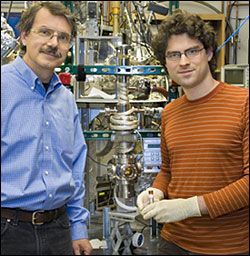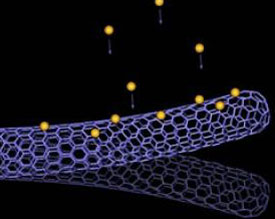BERKELEY, Calif., July 29, 2008 – A nanoelectromechanical system (NEMS) has been fashioned that can function as a scale sensitive enough to weigh a single atom of gold.
Researchers with Berkeley Lab and the University of California, Berkeley (UC Berkeley), were led by Alex Zettl, a physicist who holds joint appointments with Berkeley Lab's Materials Sciences Division (MSD) and UC Berkeley's Physics Department, where he is the director of the Center of Integrated Nanomechanical Systems. Working with him were fellow researchers Kenneth Jensen and Kwanpyo Kim.
Alex Zettl (left) and Kenneth Jensen, members of the research team that created the world's smallest and most sensitive weighing scale. (Photo courtesy Roy Kaltschmidt, Berkeley Lab Public Affairs)
"For the past 15 years or so, the holy grail of NEMS has been to push them to a small enough size with high enough sensitivity so that they might resolve the mass of a single molecule or even single atom," said Zettl. "This has been a challenge even at cryogenic temperatures where reduced thermal noise improves the sensitivity. We have achieved sub-single-atom resolution at room temperature."
The nanoscale mass sensor consists of a single carbon nanotube that is double-walled to provide uniform electrical properties and increased rigidity. One tip of the carbon nanotube is free, while the other tip is anchored to an electrode in close proximity to a counter-electrode. A DC voltage source is then connected to the electrodes, which creates a negative electrical charge on the free tip of the nanotube. An additional radio frequency wave "tickles" the nanotube, causing it to vibrate at a characteristic "flexural" resonance frequency.
When an atom or molecule is deposited onto the carbon nanotube, the tube's resonant frequency changes in proportion to the mass of the atom or molecule, much like the added mass of a diver changes the flexural resonance frequency of a diving board. Measuring this change in frequency reveals the mass of the impinging atom or molecule.
A double-walled carbon nanotube NEMS has been used to measure the mass of a single atom of gold. Atoms landing on the tube change the tube's resonant frequency in proportion to the mass of the atoms, much like what happens when a diver hits a springboard. (Photo courtesy Kenneth Jensen)
"Getting nanotubes to vibrate is fairly easy," said Jensen. "The difficult part is detecting those small vibrations. We accomplished this by field-emitting, or spraying, electrons from the tip of the nanotube and detecting the resulting electrical current."

Using their NEMS mass sensor, Zettl, Jensen and Kim were able to weigh individual gold atoms and measure masses as small as two fifths that of a gold atom at room temperature and in just a little more than one second of time. A gold atom has a mass of 3.25 x 10-25 kilograms, which means that there are about 3 million million million million gold atoms in a single kilogram.
While there have been other NEMS that function as mass sensors before, most of these previous devices were fashioned from silicon, and none had achieved the magical single-atom resolution at room temperature. The carbon nanotube mass sensor of Zettl's group is a thousand times smaller by volume than typical NEMS resonators, measuring only about a billionth of a meter in diameter and 200 billionths of a meter in length.
"Carbon nanotubes are the ideal material for this purpose and their small size makes them sensitive enough to resolve single atoms even at room temperature," Jensen said.
While scientists already have the ability to measure the mass of individual atoms through a complex technique known as mass spectrometry, this new carbon nanotube NEMS mass sensor offers some distinct advantages and opens the door to new possibilities, according to Jensen.
"Unlike mass spectrometry, our device does not require the ionization of neutral atoms or molecules that can destroy samples such as proteins,” said Jensen. “Also unlike mass spectrometers, our carbon nanotube mass sensor becomes more sensitive at higher mass ranges, which makes it more suitable for measuring large biomolecules like DNA. Finally, our device is small enough so that, in time, it could be incorporated onto a chip."
This research was supported by the U.S. Department of Energy's Office of Science, Basic Energy Sciences Program's Materials Sciences and Engineering Division, and by the National Science Foundation within the Center of Integrated Nanomechanical Systems.
For more information, visit: www.berkeley.edu